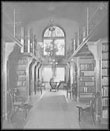
|
|
|
 |
|
 |
|
|
|
 |
|
|
|
|
|
|
|
|
|
William Henry Fox Talbot (1800-1877) |
|
|
|
|
|
Photography as we know it resulted from multiple inventions -- many of them overlapping both conceptually and chronologically -- that came from divers hands. As such, it typifies the proverbial idea whose time has come. To William Henry Fox Talbot we owe the introduction of the positive-negative process and everything that flows therefrom, most importantly the reproducibility of the photographic image via multiple prints and thus the rapidity of the medium's dissemination around the world and its imagery's infiltration of so many aspects of public and private life.
It seems somehow fitting that a philologist capable of transcribing ancient Syrian and Chaldean cuneiform texts -- an expert in dead languages, a physicist and mathematician, a classics scholar -- should have assisted so closely at the birth of a communication system that in many ways came to define the modernist (and now the post-modernist) sensibility. Deeply educated, Talbot (he referred to himself by his last name only) took up the problem of photographic representation as a frustrated and not particularly skilled draftsman, dissatisfied with the results he obtained from sketching with the aid of Wollaston's camera lucida, an artist's tool that, in the hands of a more competent worker (such as his friend and colleague Sir John Herschel) could yield remarkably detailed and accurate drawings.
|
 |
Unhappy with his own efforts, Talbot decided to solve his problem scientifically and technologically. He conducted extensive experimentation at his estate, Lacock Abbey, and corresponded widely from there with colleagues engaged in parallel inquiries. The upshot was photography as most people around the world commonly knew it from 1840 until the advent of digital imaging in the 1990s: a two-step technology involving first the creation of a matrix (the negative) and then the production of one or more renderings thereof in positive form.
Talbot wrote eloquently and at length about his discovery, discussing what led him to it, how his search evolved, what results he obtained, and what he anticipated from the medium in its future. His first discussion of it dates from 1839. His magnum opus, The Pencil of Nature, one of the key texts in the medium's history, appeared in 1844-46. Prophecies therein that no doubt seemed wild-eyed at the time have since shown themselves as, to say the least, tame. Photography -- and especially the variant thereof devised by Talbot -- rapidly became what the historian Lynn White, Jr., calls "a defining technology": one that reshapes the very way a culture thinks.
We offer here, for the very first time in cyberspace, the complete text of The Pencil of Nature, with about half of its accompanying illustrations. Eventually we will add the remaining pictures. We also offer that preliminary 1839 narrative in which he stakes out his claim for priority.
In the Photography Criticism CyberArchive:
Essays
A William Henry Fox Talbot Bibliography
- A useful Fox Talbot bibliography can be had as a free PDF download, courtesy of the National Museum of Photography, Film & Television in Bradford, England.
- Another resource: The Correspondence of William Henry Fox Talbot, which proposes nothing less than putting his entire correspondence archive of some 10,000 letters online by summer 2003.
(Photo credit: Antoine Claudet, Portrait of William Henry Fox Talbot, 1840s bromide copy of a daguerreotype, made by Herbert Lambert, 1930s. )
|
|
|
|
|
|
|
|
|
|
|
|
|
|
|
|
|
|
|
|
|
|
|
|
|
Back to top
All contents © copyright 2003-05
by A. D. Coleman/PCCA
and the authors and artists, except as indicated.
All rights reserved.
info@photocriticism.com
Site design by John Alley
|
|
|
|
|
|
|
|
|
|